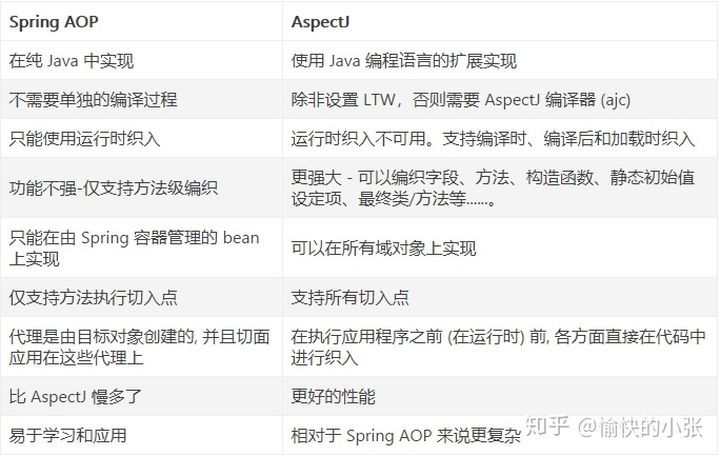Spring 入门(二) Spring AOP
本文是spring 入门教程(二),目标是学会Spring AOP 注解方式的使用。基本内容拷贝自以下参考资料:
参考资料:
理解Spring AOP
AOP(Aspect Orient Programming),它是面向对象编程的一种补充,主要应用于处理一些具有横切性质的系统级服务,如日志收集、事务管理、安全检查、缓存、对象池管理等。
AOP实现的关键就在于AOP框架自动创建的AOP代理,AOP代理则可分为静态代理和动态代理两大类,其中静态代理是指使用AOP框架提供的命令进行编译,从而在编译阶段就可生成 AOP 代理类,因此也称为编译时增强;而动态代理则在运行时借助于JDK动态代理、CGLIB等在内存中“临时”生成AOP动态代理类,因此也被称为运行时增强。
面向切面的编程(AOP) 是一种编程范式,旨在通过允许横切关注点的分离,提高模块化。AOP提供切面来将跨越对象关注点模块化。
AOP要实现的是在我们写的代码的基础上进行一定的包装,如在方法执行前、或执行后、或是在执行中出现异常后这些地方进行拦截处理或叫做增强处理。
AOP概念
- 连接点(Jointpoint):表示需要在程序中插入横切关注点的扩展点,连接点可能是类初始化、方法执行、方法调用、字段调用或处理异常等等,Spring只支持方法执行连接点,在AOP中表示为“在哪里干”;
- 切入点(Pointcut):选择一组相关连接点的模式,即可以认为连接点的集合,Spring支持perl5正则表达式和AspectJ切入点模式,Spring默认使用AspectJ语法,在AOP中表示为“在哪里干的集合”;
- 通知(Advice):在连接点上执行的行为,通知提供了在AOP中需要在切入点所选择的连接点处进行扩展现有行为的手段;包括前置通知(before advice)、后置通知(after advice)、环绕通知(around advice),在Spring中通过代理模式实现AOP,并通过拦截器模式以环绕连接点的拦截器链织入通知;在AOP中表示为“干什么”;
- 方面/切面(Aspect):横切关注点的模块化,比如上边提到的日志组件。可以认为是通知、引入和切入点的组合;在Spring中可以使用Schema和@AspectJ方式进行组织实现;在AOP中表示为“在哪干和干什么集合”;
- 引入(inter-type declaration):也称为内部类型声明,为已有的类添加额外新的字段或方法,Spring允许引入新的接口(必须对应一个实现)到所有被代理对象(目标对象), 在AOP中表示为“干什么(引入什么)”;
- 目标对象(Target Object):需要被织入横切关注点的对象,即该对象是切入点选择的对象,需要被通知的对象,从而也可称为“被通知对象”;由于Spring AOP 通过代理模式实现,从而这个对象永远是被代理对象,在AOP中表示为“对谁干”;
- AOP代理(AOP Proxy):AOP框架使用代理模式创建的对象,从而实现在连接点处插入通知(即应用切面),就是通过代理来对目标对象应用切面。在Spring中,AOP代理可以用JDK动态代理或CGLIB代理实现,而通过拦截器模型应用切面。
- 织入(Weaving):织入是一个过程,是将切面应用到目标对象从而创建出AOP代理对象的过程,织入可以在编译期、类装载期、运行期进行。
AspectJ是什么
AspectJ是一个易用的功能强大的AOP框架
AspectJ全称是Eclipse AspectJ, 其官网地址是:http://www.eclipse.org/aspectj/
引用官网描述:
AspectJ是什么:
- a seamless aspect-oriented extension to the Javatm programming language(一种基于Java平台的面向切面编程的语言)
- Java platform compatible(兼容Java平台,可以无缝扩展)
- easy to learn and use(易学易用)
AspectJ能做什么:
clean modularization of crosscutting concerns, such as error checking and handling, synchronization, context-sensitive behavior, performance optimizations, monitoring and logging, debugging support, and multi-object protocols。
干净的模块化横切关注点(也就是说单纯,基本上无侵入),如错误检查和处理,同步,上下文敏感的行为,性能优化,监控和记录,调试支持,多目标的协议。
可以单独使用,也可以整合到其它框架中。
单独使用AspectJ时需要使用专门的编译器ajc。java的编译器是javac,AspectJ的编译器是ajc,aj是首字母缩写,c即compiler。
AspectJ和Spring AOP的区别
Spring AOP
Spring AOP 属于动态织入,通过动态代理实现
- 基于动态代理来实现,默认如果使用接口的,用JDK提供的动态代理实现,如果是方法则使用CGLIB实现
- Spring AOP需要依赖IOC容器来管理,并且只能作用于Spring容器,使用纯Java代码实现
- 在性能上,由于Spring AOP是基于动态代理来实现的,在容器启动时需要生成代理实例,在方法调用上也会增加栈的深度,使得Spring AOP的性能不如AspectJ的那么好
AspectJ
- AspectJ属于静态织入,通过修改代码来实现,有如下几个织入的时机:
- 编译期织入(Compile-time weaving): 如类 A 使用 AspectJ 添加了一个属性,类 B 引用了它,这个场景就需要编译期的时候就进行织入,否则没法编译类 B。
- 编译后织入(Post-compile weaving): 也就是已经生成了 .class 文件,或已经打成 jar 包了,这种情况我们需要增强处理的话,就要用到编译后织入。
- 类加载后织入(Load-time weaving): 指的是在加载类的时候进行织入,要实现这个时期的织入,有几种常见的方法。
- 自定义类加载器来干这个,这个应该是最容易想到的办法,在被织入类加载到 JVM 前去对它进行加载,这样就可以在加载的时候定义行为了。
- 在 JVM 启动的时候指定 AspectJ 提供的 agent:-javaagent:xxx/xxx/aspectjweaver.jar。
- AspectJ可以做Spring AOP干不了的事情,它是AOP编程的完全解决方案,Spring AOP则致力于解决企业级开发中最普遍的AOP(方法织入)。而不是成为像AspectJ一样的AOP方案。
- 因为AspectJ在实际运行之前就完成了织入,所以说它生成的类是没有额外运行时开销的。
对比总结

Spring AOP 注解实现实例
下面是一个AOP拦截有注解的方法,进行横向增强的例子。例子直接是网上github找的慕课的代码:
1. 引入AspectJ面向切面依赖
在POM.xml中引入aspectJ需要的jar包
1 | <dependency> |
2. @AspectJ 启用切面支持
新建Spring配置类,@EnableAspectJAutoProxy注解启用切面支持
1 | package org.example.spring.aop; |
3. 创建一个将要被拦截的方法注解
1 | package org.example.spring.aop.aspectj; |
4. 创建一个将要拦截的业务类
1 | package org.example.spring.aop.aspectj.biz; |
5. 申明一个切面(Aspect)
要注意的是,在Spring AOP中,切面aspect不能成为其他切面的通知的目标,有@Aspect注解的类,会被标记为一个切面,并排除被自动代理。
具体的@Pointcut可用的拦截表达式,可参考【第六章】 AOP 之 6.5 AspectJ切入点语法详解 ——跟我学spring3,要注意的是,Spring AOP仅支持拦截方法。
1 | package org.example.spring.aop.aspectj; |
6. 创建应用,并执行,查看效果
1 | package org.example.spring.aop; |





